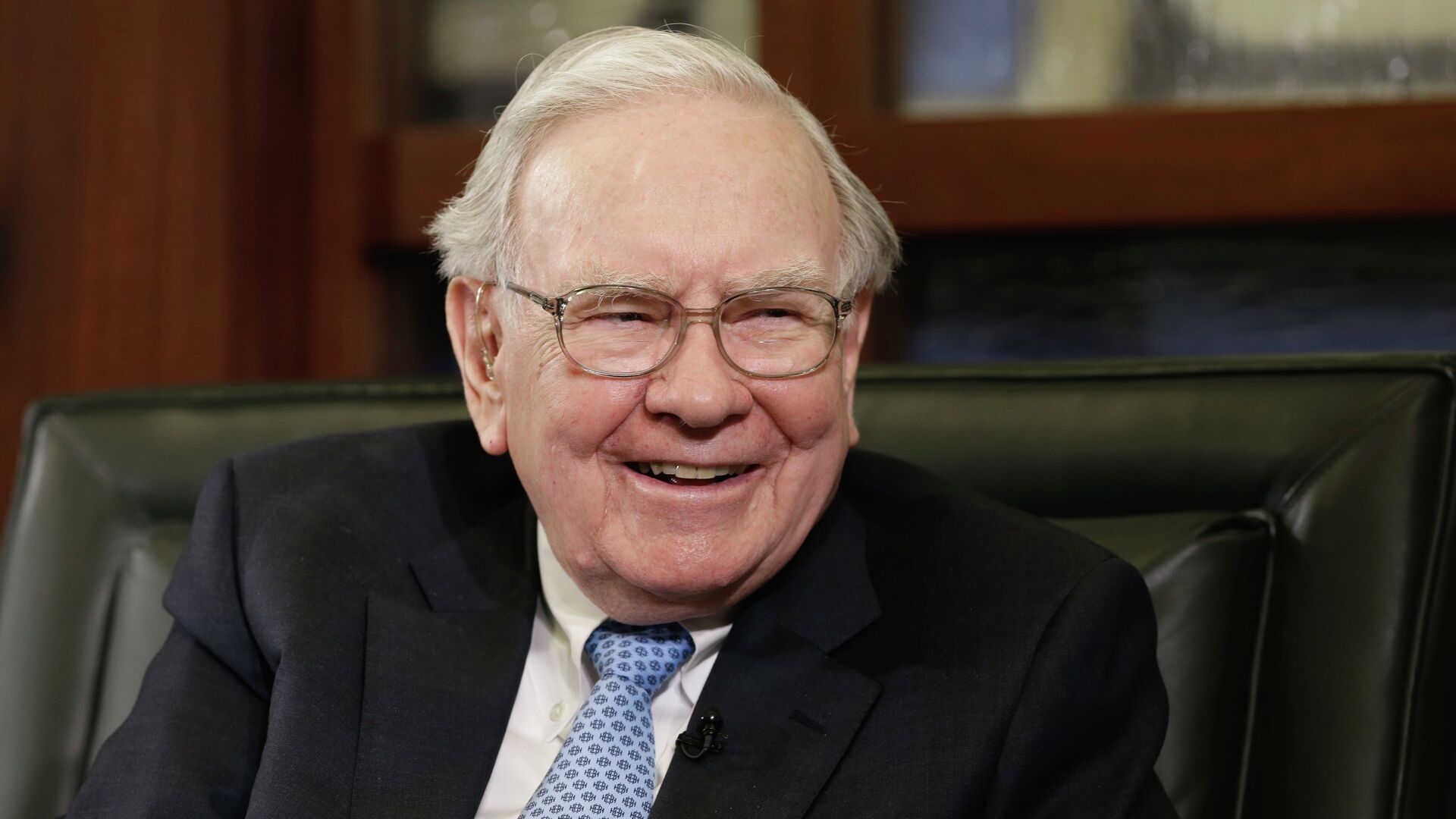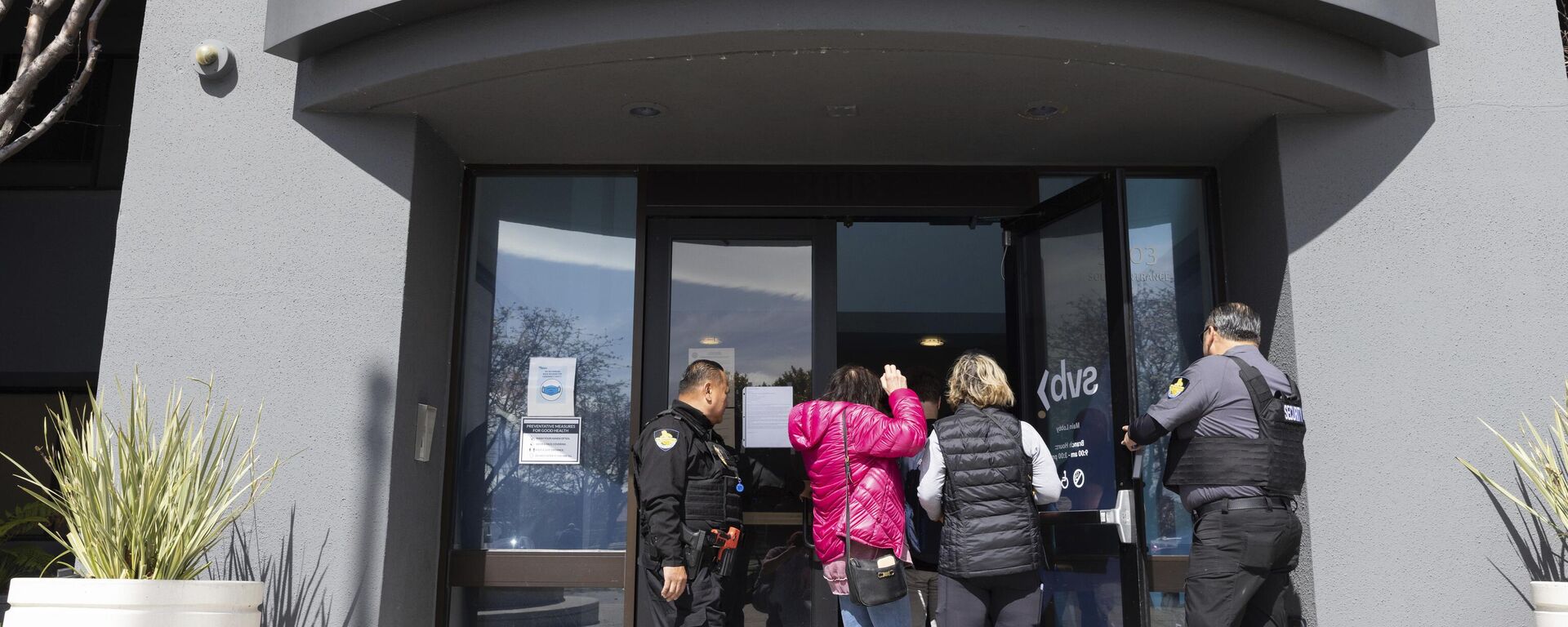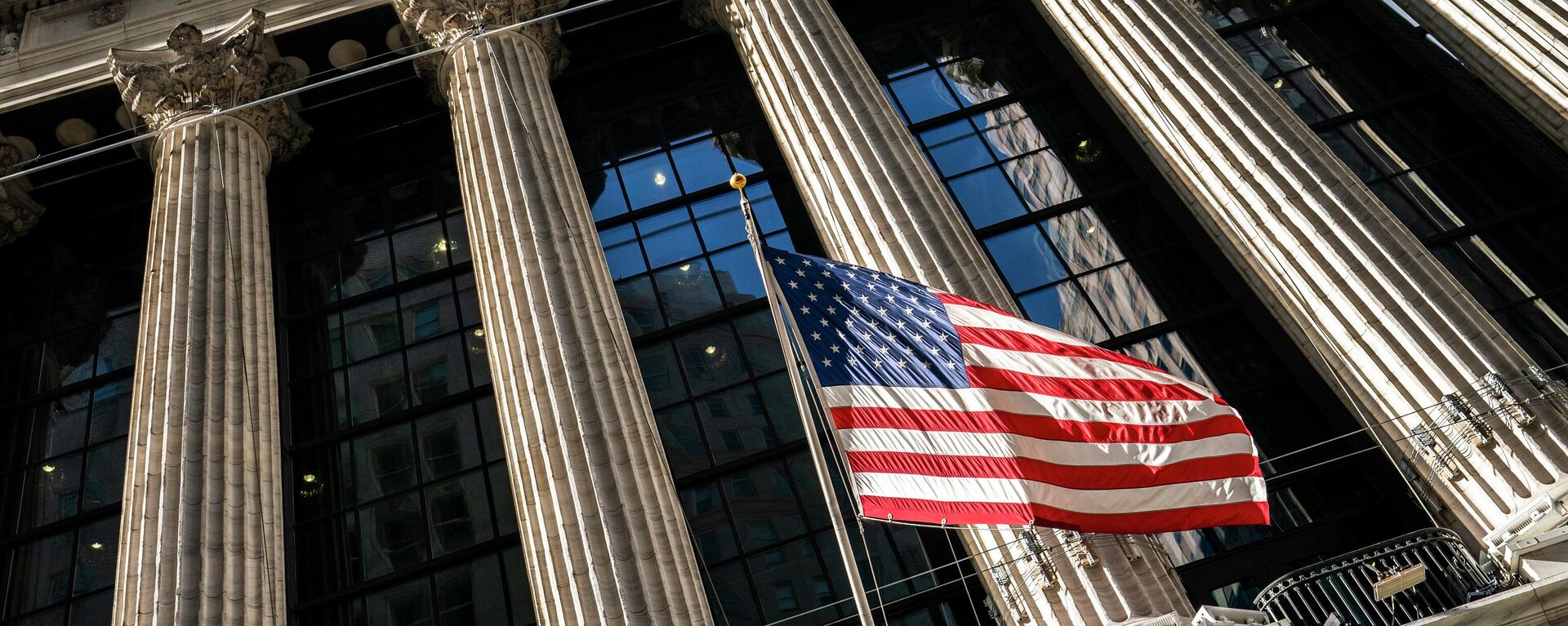https://sputnikglobe.com/20230319/warren-buffett-advising-white-house-on-banking-dumpster-fire-as-economists-compare-it-to-2008-1108576804.html
Warren Buffett Advising White House on Banking Dumpster Fire as Economists Compare It to 2008 Crisis
Warren Buffett Advising White House on Banking Dumpster Fire as Economists Compare It to 2008 Crisis
Sputnik International
The veteran 92-year-old business magnate and billionaire investor knows a thing or two about saving troubled banks (with a healthy profit for himself, naturally) and advising the Treasury Department on policy matters. In 2008, Bush administration officials credited him with helping stave off a global depression.
2023-03-19T17:48+0000
2023-03-19T17:48+0000
2023-03-19T17:48+0000
economy
joe biden
warren buffett
silicon valley bank collapse
advice
banking
https://cdn1.img.sputnikglobe.com/img/101886/09/1018860995_0:270:5184:3186_1920x0_80_0_0_bc71f8765d5068c6de70ad724f92c183.jpg
Berkshire Hathaway CEO and celebrity Wall Street whale investor Warren Buffett has reportedly discussed the banking crisis sparked by the collapse of Silicon Valley Bank with Biden administration officials, and a possible investment by his firm to shore up regional banks amid market jitters.Sources told several US outlets that there have been “multiple” discussions between Mr. Buffett and Biden officials, with the talks taking place over the past week.White House and Treasury officials offered no comment, and Berkshire Hathaway reps similarly had nothing to say about the reports.Buffett has a reputation for swooping in times of crisis to offer advice to officials and invest billions of his hedge fund’s cash to help stabilize troubled banks and offer policy advice. During the banking crisis of 2007-2008, he famously encouraged then-Treasury Secretary Hank Paulson to pump hundreds of billions of dollars into the banking system using Troubled Asset Relief Program (TARP) funds to prevent a total collapse.Most economists credit the advice with helping to stave off an immediate plunge into a global depression. However, some have also criticized the approach, saying it privatized gains made by big banks while socializing the losses, making taxpayers foot the bill and adding trillions to the US national debt. Some policymakers have also said that the depression Washington helped to avert led to decade-long great recession.During the 2008 crisis, Buffett also invested $5 billion into Goldman Sachs to strengthen the bank’s financial indicators. The investment got him his money back, plus $3.1 billion in profit. Rinse and repeat in 2011, when Berkshire Hathaway put $5 billion into the Bank of America, which got into financial trouble after purchasing insurance and financial services giant Countryside Financial. Buffett’s investment helped stabilize the bank, and eventually earned Berkshire Hathaway a $12 billion profit.Judging by past experience, whatever the subject matter of Buffett’s talks with Washington officials, one can rest assure that the billionaire, who bought his first stock at age 11 in 1941, won’t be interested in making an investment that would lose him money.SVB Fallout Continues to SimmerSilicon Valley Bank’s swift collapse last week, and the collapse of Signature, Silvergate, and Credit Suisse shortly after, sparked fears that more banks may disappear in the coming weeks. A study by the Social Science Research Network has estimated that nearly 200 other smaller banks are at risk of going under.The Biden administration took a number of steps to try to mitigate the crisis, promising to make all of SVB’s deposit holders whole (including accounts with more than $250,000 – the Federal Deposit Insurance Corporation payout limit), and agreeing to a lending program covering potentially vulnerable small and medium-size banks. Large US banks have pumped in $30 billion to rescue First Republic Bank this week after fears that it too would collapse, with the decision praised by economists.“Importantly, it looks like this safety net is not being paid by taxpayers’ dollars (e.g. the FDIC facility is financed through taxes on bank members) and it is effectively targeted to helping depositors, not management or speculators, which clearly makes it much more palatable from a political point of view,” economics professor and Griffith Business School dean Fabrizio Carmignani told Sputnik in an interview.Otherwise, he said, while the issue in 2008 “was that a number of financial institutions and investors held excessively risky and low-quality financial assets,” the problem today, at least for banks like SVB, is that they were invested “in very safe assets, such as Treasury securities, whose value dropped following the increase in interest rates.”“An interesting feature of the current situation, which we did not necessarily observe back in 2008, is the ongoing inflationary hike. To reduce inflation, central banks worldwide have increased interest rates, and this is what has led to a decline in the value of Treasury securities. At the same time, when the banking system is under pressure, ensuring liquidity is important to prevent an escalation of the situation. But ensuring the liquidity of the system would require pausing the interest rates hike. So, the question is to what extent the Fed, and other central banks, will be prepared to put on hold their fight against inflation and not increase the interest rates in the short term,” Carmignani noted.For his part, Ashraf Patel, a senior research associate with the South Africa-based Institute for Global Dialogue, expects that because SVB was a specialist bank whose customers were largely tech companies and consumer-retail banking, the current crisis won’t carry the same endemic, planetary-wide character as the 2008 collapse did. Amid the “mini meltdown” of tens of thousands of job losses even before the bank went under, Patel posits that the current situation is a sign that this tech sector is “restructuring.”“SVB’s collapse may mean less capital for new start-ups, and hence put brakes on a fast growing sector with large market capitalisation, and in a slow recessionary economy. So yes, right now it is a concern for regulators and policy makers in the US and some nations concerned about the spill over effect,” the observer said.
https://sputnikglobe.com/20230319/democrats-defend-vote-for-deregulation-law-blamed-for-svb-collapse-1108552672.html
https://sputnikglobe.com/20230318/at-least-186-us-banks-at-potential-risk-of-a-run-similar-to-svb-economists-warn--1108531654.html
https://sputnikglobe.com/20230317/recession-insolvency-derivative-risks-why-looming-us-crisis-could-be-worse-than-in-2008-1108517439.html
Sputnik International
feedback@sputniknews.com
+74956456601
MIA „Rossiya Segodnya“
2023
News
en_EN
Sputnik International
feedback@sputniknews.com
+74956456601
MIA „Rossiya Segodnya“
Sputnik International
feedback@sputniknews.com
+74956456601
MIA „Rossiya Segodnya“
warren buffett, advice, joe biden, white house, biden administration, banking crisis
warren buffett, advice, joe biden, white house, biden administration, banking crisis
Warren Buffett Advising White House on Banking Dumpster Fire as Economists Compare It to 2008 Crisis
The veteran 92-year-old business magnate and billionaire investor knows a thing or two about saving troubled banks (with a healthy profit for himself, naturally) and advising the Treasury Department on policy matters. In 2008, Bush administration officials credited him with helping stave off a global depression.
Berkshire Hathaway CEO and celebrity Wall Street whale investor Warren Buffett has reportedly discussed the banking crisis sparked by the collapse of Silicon Valley Bank with Biden administration officials, and a possible investment by his firm to shore up regional banks amid market jitters.
Sources
told several US
outlets that there have been “multiple” discussions between Mr. Buffett and Biden officials, with the talks taking place over the past week.
White House and Treasury officials offered no comment, and Berkshire Hathaway reps similarly had nothing to say about the reports.
Buffett has a reputation for swooping in times of crisis to offer advice to officials and invest billions of his hedge fund’s cash to help stabilize troubled banks and offer policy advice. During the banking crisis of 2007-2008, he
famously encouraged then-Treasury Secretary Hank Paulson to pump hundreds of billions of dollars into the banking system using Troubled Asset Relief Program (TARP) funds to prevent a total collapse.
Most economists credit the advice with helping to stave off an immediate plunge into a global depression. However, some have also criticized the approach, saying it privatized gains made by big banks while socializing the losses, making taxpayers foot the bill and adding trillions to the US national debt. Some policymakers have also
said that the depression Washington helped to avert led to decade-long great recession.
During the 2008 crisis, Buffett also invested $5 billion into Goldman Sachs to strengthen the bank’s financial indicators. The investment got him his money back, plus
$3.1 billion in profit. Rinse and repeat in 2011, when Berkshire Hathaway put $5 billion into the Bank of America, which got into financial trouble after purchasing insurance and financial services giant Countryside Financial. Buffett’s investment helped stabilize the bank, and eventually earned Berkshire Hathaway a
$12 billion profit.Judging by past experience, whatever the subject matter of Buffett’s talks with Washington officials, one can rest assure that the billionaire, who bought his first stock at age 11 in 1941, won’t be interested in making an investment that would lose him money.
SVB Fallout Continues to Simmer
Silicon Valley Bank’s swift collapse last week, and the collapse of Signature, Silvergate, and Credit Suisse shortly after, sparked fears that more banks may disappear in the coming weeks. A study by the Social Science Research Network has
estimated that nearly 200 other smaller banks are at risk of going under.
The Biden administration took a number of steps to try to mitigate the crisis, promising to make all of SVB’s deposit holders whole (including accounts with more than $250,000 – the Federal Deposit Insurance Corporation payout limit), and agreeing to a lending program covering potentially vulnerable small and medium-size banks. Large US banks have pumped in $30 billion to rescue First Republic Bank this week after fears that it too would collapse, with the decision praised by economists.
“Importantly, it looks like this safety net is not being paid by taxpayers’ dollars (e.g. the FDIC facility is financed through taxes on bank members) and it is effectively targeted to helping depositors, not management or speculators, which clearly makes it much more palatable from a political point of view,” economics professor and Griffith Business School dean Fabrizio Carmignani told Sputnik in an interview.
Carmignani said the 2008 banking crisis and what is happening today can be compared, but only “in the sense that – as it is almost always the case in modern banking crisis – the psychological response of consumers to ‘bad news’ (whatever the root causes of this bad news are) is to run to the banks and withdraw their deposits.”
Otherwise, he said, while the issue in 2008 “was that a number of financial institutions and investors held excessively risky and low-quality financial assets,” the problem today, at least for banks like SVB, is that they were invested “in very safe assets, such as Treasury securities, whose value dropped following the increase in interest rates.”
“An interesting feature of the current situation, which we did not necessarily observe back in 2008, is the ongoing inflationary hike. To reduce inflation, central banks worldwide have increased interest rates, and this is what has led to a decline in the value of Treasury securities. At the same time, when the banking system is under pressure, ensuring liquidity is important to prevent an escalation of the situation. But ensuring the liquidity of the system would require pausing the interest rates hike. So, the question is to what extent the Fed, and other central banks, will be prepared to put on hold their fight against inflation and not increase the interest rates in the short term,” Carmignani noted.
For his part, Ashraf Patel, a senior research associate with the South Africa-based Institute for Global Dialogue, expects that because SVB was a specialist bank whose customers were largely tech companies and consumer-retail banking, the current crisis won’t carry the same endemic, planetary-wide character as the 2008 collapse did. Amid the “mini meltdown” of tens of thousands of job losses even before the bank went under, Patel posits that the current situation is a sign that this tech sector is “restructuring.”
“SVB’s collapse may mean less capital for new start-ups, and hence put brakes on a fast growing sector with large market capitalisation, and in a slow recessionary economy. So yes, right now it is a concern for regulators and policy makers in the US and some nations concerned about the spill over effect,” the observer said.





